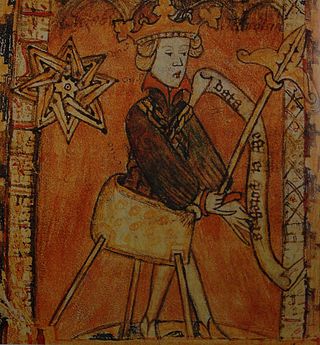
Valdemar IV Atterdag, Valdemar Christoffersen or Waldemar was King of Denmark from 1340 to 1375. He is mostly known for his reunion of Denmark after the bankruptcy and mortgaging of the country to finance wars under previous rulers.

Gerhard III of Holstein-Rendsburg, sometimes called Gerhard the Great, and in Denmark also known as Count Gert or den kullede greve, was a German prince from the Schauenburg family who ruled Holstein-Rendsburg and a large part of Denmark during the interregnum of 1332–40.

John III of Holstein-Plön, called John the Mild, was a Count of Schauenburg and Holstein-Plön and Holstein-Kiel, ruling Holstein-Plön and Holstein-Kiel (1316–1359). Together with Count Gerhard III of Holstein-Rendsburg, John III was the lord ruling in guardianship the Danish Duchy of Schleswig 1332–1340. He was known as “John the Mild”.

Helvig of Schleswig was the queen of Denmark as the spouse of King Valdemar IV. She was the mother of Queen Margaret I of Denmark.

The House of Estridsen was a dynasty that provided the kings of Denmark from 1047 to 1412. The dynasty is named after its ancestor Estrid Svendsdatter. The dynasty is sometimes called the Ulfinger, after Estrid's husband, Ulf Jarl. The dynasty also provided three medieval rulers of Sweden and one of Norway. Their family coat of arms became the coat of arms of Denmark and thereby influenced the coat of arms of Tallinn and the coat of arms of Estonia.
The Wars of the Rügen Succession were two early 14th century conflicts fought primarily between Mecklenburg and Pomerania for control of the Danish Principality of Rügen on the southern Baltic Sea coast.
Events from the 14th century in Denmark.
Events in the 1340s in Denmark.

The Kalundborg War was a conflict spanning three years between Sweden, Norway and Holstein, and an alliance consisting of Denmark, Lübeck, Hamburg, Rostock, Wismar, Greifswald, and Stralsund. Although Denmark achieved some victories, the war ended favourably for Sweden, Norway and Holstein.

The siege of Lindholmen was a siege of the former Danish castle of Lindholmen in Scania during the Danish-Hanseatic War of 1361 – 1370 between Sueco–Hanseatic and Danish forces. The siege ended in a Danish victory: the Hanseatic leader Bruno Warendorp was killed, and the siege was subsequently lifted.

The siege of Copenhagen or the Capture of Copenhagen, was a looting and siege of Copenhagen and Absalon's Castle in 1368 between Denmark and the Hanseatic League, during the Danish-Hanseatic War (1361–1370). The city was looted and Absalon's castle was destroyed.

The siege of Nykøbing or the siege of Nykøbing Castle, was a siege of Nykøbing Castle, Falster, between Danish and Swedish forces during the Danish-Hanseatic War (1361–1370). The siege ended in a Swedish victory, though the Danes were able to achieve a good instrument of surrender.

The siege of Vordingborg was a siege between the Hanseatic and Danish forces at Vordingborg, Zealand during the Danish–Hanseatic War (1361–1370). The Danes managed to defend Vordingborg for two years until peace was settled at Stralsund.

The siege of Helsingborg was a siege of the then-Danish city of Helsingborg between 1368 and 1369 during the Danish–Hanseatic War (1361–1370). Despite withstanding many sieges, Helsingborg would capitulate to the Hanseatic League.

The siege of Kolding also known as the siege of Koldinghus, was a siege by the County of Holstein on the Danish castle of Koldinghus in 1368 during the Danish–Hanseatic War (1361–1370). The siege would end inconclusive for both sides, however, the commander of the castle, Peder Iversøn, promised to surrender if King Valdemar IV of Denmark would die, abdicate, or lose the kingdom. Presumeably, Iversøn surrendered at last, since he would not be mentioned in the later peace talks.

The Battle of Lundenæs, also known as the Battle of Skjern River was a military engagement between Holsteinian and Jutish rebel forces on 2 May 1340 possibly at Lundenæs Castle near Skjern River in the then Holsteinian-held Jutland. The battle ended in a Jutish rebel victory and it is alleged that many Germans died in the Skirmish.

The siege of Skanderborg, alternatively the siege of Skanderborg Castle, was a siege of the Holsteinian-held Skanderborg Castle in Jutland by Jutish rebels led by Niels Ebbesen. Despite being close to surrendering, the Holsteinian garrison received a relief force led by Henry II of Holstein-Rendsburg and defeated the Danes in the Battle of Nonnebjerg on 2 November 1340.

The Battle of Nonnebjerg, also known as the Battle of Skanderborg and the Battle of Marbjerg, was a battle near Skanderborg Castle on 2 November 1340 between Holsteinian and Danish rebel forces. The result is generally considered a German victory, with the Danish rebel leader, Niels Ebbesen being killed in action.

The siege of Kolding also known as the siege of Koldinghus, was a siege by Jutish rebels on the Holsteinian-held Castle of Koldinghus in 1341. The siege ended unsuccessful, and Count Henry II of Holstein-Rendsburg retaliated by raiding much of Jutland.

The Battle of Blidebro was a battle between Danish–German and Swedish–Holsteinian forces near Copenhagen in 1342 during the Kalundborg War. The battle ended in a Danish–German victory and it is estimated that 350 Swedes were killed in the initial action.


















